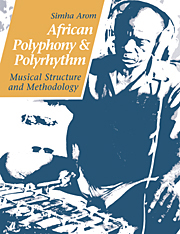Book contents
- Frontmatter
- Contents
- List of illustrations
- Foreword by György Ligeti
- Preface
- Acknowledgements
- BOOK I THE MUSIC OF THE CENTRAL AFRICAN REPUBLIC
- BOOK II AFRICAN POLYPHONIC MUSIC
- BOOK III TECHNICAL TOOLS: METHODS OF RECORDING POLYPHONIC MUSIC FOR TRANSCRIPTION
- 1 The need for transcription
- 2 The difficulties of transcription
- 3 Earlier methods
- 4 Towards a new method
- 5 Theoretical assumptions
- 6 Technical equipment: description and use
- 7 From recording to transcription
- 8 Checking the results
- 9 Potentialities
- 10 Anthropological validity
- BOOK IV THEORETICAL TOOLS
- BOOK V THE ORGANISATION OF TIME IN AFRICAN MUSIC
- BOOK VI STRUCTURAL PRINCIPLES AND THEIR APPLICATION
- Conclusion
- Bibliography
2 - The difficulties of transcription
Published online by Cambridge University Press: 27 January 2010
- Frontmatter
- Contents
- List of illustrations
- Foreword by György Ligeti
- Preface
- Acknowledgements
- BOOK I THE MUSIC OF THE CENTRAL AFRICAN REPUBLIC
- BOOK II AFRICAN POLYPHONIC MUSIC
- BOOK III TECHNICAL TOOLS: METHODS OF RECORDING POLYPHONIC MUSIC FOR TRANSCRIPTION
- 1 The need for transcription
- 2 The difficulties of transcription
- 3 Earlier methods
- 4 Towards a new method
- 5 Theoretical assumptions
- 6 Technical equipment: description and use
- 7 From recording to transcription
- 8 Checking the results
- 9 Potentialities
- 10 Anthropological validity
- BOOK IV THEORETICAL TOOLS
- BOOK V THE ORGANISATION OF TIME IN AFRICAN MUSIC
- BOOK VI STRUCTURAL PRINCIPLES AND THEIR APPLICATION
- Conclusion
- Bibliography
Summary
In our discussion of earlier works on the subject, we noted that little attention has been devoted to African polyphony. Unlike many other aspects of music transmitted by oral tradition, reference transcriptions of African polyphony are rarely available, and when provided are only fragmentary at best. This seems to be mainly attributable to the difficulty of transcribing this kind of music. Several experts, among them Bruno Nettl (1964:84), have pointed out the problems involved:
Special problems in eliciting appear when the musical structure is complex, especially if a performance is by several singers, instruments, etc.
It is almost impossible to transcribe a record on which several xylophones of equal size are playing together if one does not know the number of xylophones. Even when the number and size of the instruments is known, it is extremely difficult to notate what each individual one is playing. It may be possible to reproduce the overall acoustic impression, but this may be misleading.
Gerhard Kubik (1961: 200) is equally sceptical about transcribing African instrumental music: ‘Transcription of African instrumental music from tape recordings poses enormous problems. In most cases, it will lead to incorrect results.’ In a subsequent publication on xylophone music (1964a), Kubik reaffirms that transcription from tape recordings is impossible. He suggests instead that an attempt be made to learn to play an African instrument before transcription is undertaken. We will return below to the effectiveness of this approach.
- Type
- Chapter
- Information
- African Polyphony and PolyrhythmMusical Structure and Methodology, pp. 95 - 96Publisher: Cambridge University PressPrint publication year: 1991



